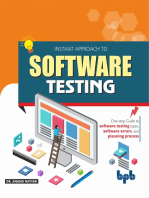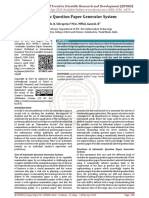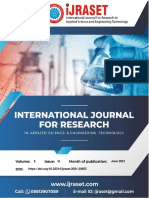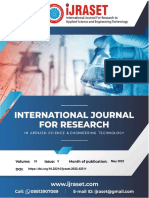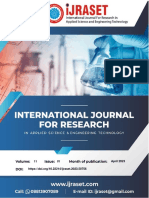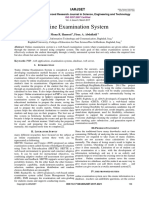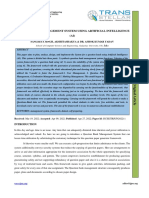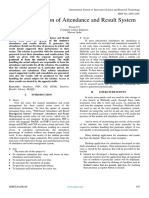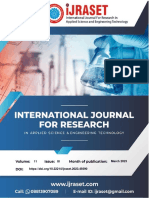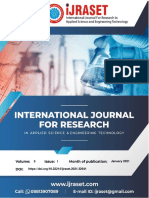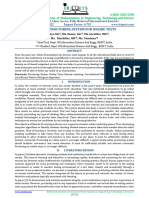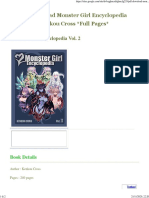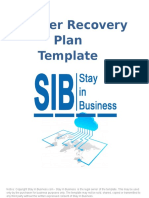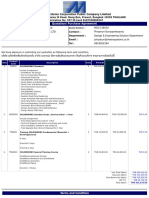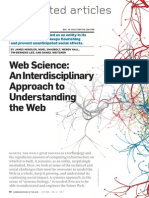Professional Documents
Culture Documents
Question Bank Based Paper Setting An Automatic Question Paper Generation System
Original Title
Copyright
Available Formats
Share this document
Did you find this document useful?
Is this content inappropriate?
Report this DocumentCopyright:
Available Formats
Question Bank Based Paper Setting An Automatic Question Paper Generation System
Copyright:
Available Formats
Volume 6, Issue 5, May – 2021 International Journal of Innovative Science and Research Technology
ISSN No:-2456-2165
Question Bank Based Paper Setting
An Automatic Question Paper Generation System
Meetali Dulera Kunal Chugriya Vrudhi Israni
Student Student Student
Computer Department Computer Department Computer Department
VESIT VESIT VESIT
Rahul Tejwani Prashant Kanade
Student Assnt. Professor:
Computer Department Computer Department
VESIT VESIT
Abstract:- In this paper there is a proposal for a duplicated and circulated before the examination takes
question bank based paper setting system. In the place. There are provisions for entering and manipulating
proposed model the major stakeholders are members of data that are appropriate for any educational institution and
the examination control unit, Paper setters, chief that have the ability to add courses, semesters, subjects etc.
moderator who will act as administrator. Faculty This enables an educational institution to generate questions
members are paper setters who will provide the set of that ensure the safety and non-repetition of questionnaires
questions to the admins who will insert them into the and is a boon for organizations with limited staff and
database. The questions are stored in a database along resources.
with their weightage, topic, subject and difficulty level.
Whenever there is a need to set the paper, the system Our system aims to provide fast processes, data
selects questions randomly in a way that their weight age storage and a high level of security for all of the tasks. The
makes up for 100 marks . The paper setter has an option Question Paper Generator system will automatically
to select how many difficult questions and how many generate the paper and prepare the document file according
easy questions should be present in the generated paper. to the selected subject, marks and difficulty. To ensure
Paper setting process is very flexible. Generated paper is safety, before the question paper is made visible, the user is
converted to a pdf file and emailed to colleges on button asked to re-enter its password in order to confirm their
click. identity. The generated question paper will be converted to a
PDF file and will be emailed to the universities by clicking
Keywords:- Optical Character Recognition; Educational the button.
Technology; Product Development; Graphical User
Interface. II. RELEVANCE
I. INTRODUCTION Covid-19 has urged various sectors to go digital. It is a
digital era where tasks are going digital as much as possible.
Traditionally, exam writing has been done manually Hence, there is a need for an online, digital way for setting
using the knowledge, experience, and style of the reputed Question papers. The predominant methodology is that a
teachers of institutions. Despite the high recognition of the specific number of faculties are handed over a syllabus and
questions, there are still some shortcomings. The main assigned the task of framing a question paper out of it. Out
problem is the low quality of the exam papers caused by of all the papers created, one is chosen at random and used
some human factors like fatigue and a relatively narrow for the examination. This method is stated as a Classical
range of topics. Teachers spend a lot of time and energy Method.
while creating exam papers. A way to automate this tedious
process is the need of the day. Therefore, automatic exam This system suffers from the subsequent
question paper generation is an important topic to be worked disadvantages: dependency on intelligence of one person
upon. may raise the chance of errors, important parts of the
syllabus may go unnoticed, secrecy may get compromised
In today's world, time is a major concern. Any product and full utilization of resources might not be possible, thus
that can effectively reduce time and power consumption is making it inefficient. Consistent with the need, an
accepted and valued. Therefore, we are introducing a autonomous system for question paper generation has been
question bank based paper setting system, which reduces proposed. Creating a question paper through our system
time consumption by replacing the conventional method of makes it a lot more efficient, reliable, improves its quality,
the system for producing question paper. It also requires less and also cuts back the time taken by instructors in setting the
manpower.We have implemented a role-based hierarchy that question papers manually.
restricts access to users. The system also uses security
mechanisms that prevent questionnaires from being
IJISRT21MAY239 www.ijisrt.com 233
Volume 6, Issue 5, May – 2021 International Journal of Innovative Science and Research Technology
ISSN No:-2456-2165
III. PROPOSED SYSTEM character recognition) based question insertion procedure,
which allows the users to enter multiple questions together.
Our proposed model is special and unique software, The second feature is the flexibility of adjusting the number
which will provide ease of entering questions and making of easy and difficult sub-questions within every question.
the question generation process extremely efficient. Two of This results in the generation of strong and balanced
the main features of our system are an OCR (optical question papers.
Fig. 1. Block diagram of proposed system
Fig. 2. Data Flow Diagram of proposed system
IV. FUNCTIONAL REQUIREMENTS
IJISRT21MAY239 www.ijisrt.com 234
Volume 6, Issue 5, May – 2021 International Journal of Innovative Science and Research Technology
ISSN No:-2456-2165
A. Login questions from the uploaded PDF documents.
The login module will be restricted to very few trusted When the user uploads a PDF document that has been made
people only. It will be password protected and nobody else in a predetermined format, our system recognizes the
should be given access to the system in order to maintain questions, their marks and their difficulty status.
security and prevent frauds. The system displays all the extracted questions to the user
for a verification before inserting them into the database.
B. Question insertion This technology makes the question insertion process
The user can insert questions into the database by extremely easy.
either entering one question at a time or by uploading a pdf
filled with questions. In this way, the user can collect pdfs ● The SQL SELECT RANDOM() function returns a
from different teachers and maintain the security by random row from the database. It is often used in online
reducing the number of users for the system. exams to display the random questions without repetition
or duplication.
C. Filling up required fields
The inserted questions will have the following fields How did we use it in our system?
associated with them: Semester, Subject, Marks, Difficulty We used the RAND() function to extract random questions
and Topic. from the database and create the question paper.
Once the user has entered its required number of
D. Generation questions, marks and difficulty levels, this RAND() function
The user has to fill a form which gives an option to acts on it to select random questions that fulfill the criterias.
choose the number of difficult and the number of easy sub
questions for every question. It also gives an option to It helps in prevention repetition or duplicacy of
choose the number of 5 mark sub questions and 10 mark questions.
questions within every question. Finally, the admin has to
select the subject name and then click on the generate VI. RESULTS
button. Now the database is triggered and the system
extracts random questions from the database that fulfill the
given criteria.
E. Confirmation
Before being able to view the question paper, the user
is asked to re-enter its password to prove that the person
requesting the paper can be trusted or not. This adds an
additional security measure into our system.
V. METHODS AND PROCEDURES
The steps followed for the execution of the system
were as follows
● Creating a database in SQLite to store questions
● Creating a form to enter questions into the database Fig. 3. Dashboard of proposed system
● Creating an option for inserting questions into the
database through a PDF format.
● Creating a “Generate paper” form.
● Converting the generated paper into PDF and
downloading it.
● Creating appropriate front end and backend and
integrating it using flask
The algorithms implemented were as follows
● OPTICAL CHARACTER RECOGNITION (OCR) is the
use of technology to distinguish printed or handwritten
text characters inside digital images of physical
documents, such as a scanned paper document. The basic
process of OCR involves examining the text of a
document and translating the characters into code that Fig. 4.
can be used for data processing. OCR is sometimes also List of available subjects
referred to as text recognition.
How did we use OCR in our system?
We used optical character recognition for recognizing
IJISRT21MAY239 www.ijisrt.com 235
Volume 6, Issue 5, May – 2021 International Journal of Innovative Science and Research Technology
ISSN No:-2456-2165
VII. FUTURE SCOPE
In future, more features can be included to generate
question paper for online and offline MCQ examinations.
This eliminates the problem of paper leak cases in the
prestigious examinations.Thus, making the examination
process more effective and secure. We can work on
improving security features of the system to make it as
secure as possible. We can also use natural language
processing to create questions from the entered paragraph
automatically. Question insertion tasks can be made more
easier and user friendly. We can collaborate with an exam
department team to discuss the minute security details which
can be added. Work can be done in making the system more
Fig. 5. Form to insert a new subject accessible and reliable for the institutions to use. There can
be a feature of adding a portal for students to generate
sample question papers and practicing for the examination.
Making provisions for collaboration of different colleges to
get a more diverse and rich set of questions. Adding
algorithms that automatically detect duplicate questions
from the system and deleting it. Adding an answers section
for each entered question. While generating a question
paper, a sample answer key will also be generated for the
teachers.
VIII. CONCLUSION
We have created a question bank based paper setting
Fig. 6. Form to enter a new question system which provides a wide portion coverage and strong,
efficient question paper generation. Paper leak chances are
reduced. Transportation of papers from one college to
another is no longer required. The system provides an
unbiased result. Time consumption and human efforts are
reduced significantly by using our system. We have created
a user-friendly web based application with some unique
features like uploading a file filled with questions for
inserting multiple questions together; and flexibility of
adjusting the marks and difficulty of questions. This system
can be used in various institutes and colleges for the purpose
of question paper generation.
ACKNOWLEDGMENT
Fig. 7. Multiple questions entered together by uploading a We express our deepest sense of gratitude towards our
PDF filled with questions respected and noble guide Mr. Prashant Kanade for
spending his valuable time on several occasions to impart us
the gains of his knowledge. It was our privilege to have
work under his guidance. We shall always remain indebted
to him. His guidance helped us in all the time of research
and writing of this paper. We could not have imagined
having a better advisor and mentor for my Final year
project. We express our gratitude for his encouragement,
insightful comments, and hard questions. We would also
like to thank our college Vivekanand education society’s
institute of technology, and all its teachers of the computer
department for giving us great opportunities of working on
amazing projects.
Fig. 8. Form for generating question paper
REFERENCES
IJISRT21MAY239 www.ijisrt.com 236
Volume 6, Issue 5, May – 2021 International Journal of Innovative Science and Research Technology
ISSN No:-2456-2165
[13]. Zalte, S. V, Jadhav, C. C., Mangier, A. A., Hole, A.
[1]. Janpla, Satien & Wanapiron, P.. (2018). System D., & Tulshi, A. R. (2018). “Automatic Question
framework for an intelligent question bank and Paper Generator System”. Cim, pp[545–548].
examination system. International Journal of Machine Https://doi.org/10.17148/IJARCCE.2018.73103
Learning and Computing. 8. 488-494. [14]. Dhawaleswar Rao Ch and Sujan Kumar Saha,
10.18178/ijmlc.2018.8.5.734. “Automatic Multiple Choice Question Generation
[2]. Kurdi, G., Leo, J., Parsia, B. et al. A Systematic from Text: A Survey”, IEEE, 2018.
Review of Automatic Question Generation for [15]. Liancheng guan, “The design of the automatic
Educational Purposes. Int J Artif Intell Educ 30, 121– generative system of examination papers”,
204 (2020). https://doi.org/10.1007/s40593-019- IEEE,pp[110-113], 2017.
00186-y [16]. Gauri Nalawade, Rekha Ramesh” Automatic
[3]. Zolait, Ali & El-Rahman, Sahar. (2018). Automated Generation of Question Paper from User Entered
Test Paper Generation Using Utility Based Agent and Specifications using a Semantically Tagged Question
Shuffling Algorithm. International Journal of Web- Repository” IEEE 8th International Conference on
Based Learning and Teaching Technologies. 14. Technology for Education, 2016.
10.4018/IJWLTT.2019010105. [17]. Jun Araki, Dheeraj Rajagopal, Sreecharan
[4]. Rawat, Mrs Asha, Priyesh Solanki, Manish Patil, Sankaranarayanan, Susan Holm, Yukari Yamakawa,
Shraddha Mhetre, and Urvashi Bhadarka. Teruko Mitamura “Generating Questions and
"QUESTION PAPER GENERATOR SYSTEM." Multiple-Choice Answers using Semantic Analysis of
[5]. Naik, K., Sule, S., Jadhav, S. and Pandey, S., 2014. Texts” International Conference on Computational
Automatic Question paper Generation System using Linguistics: Technical Papers, pages 1125–1136,
randomization algorithm. International Journal of Osaka, Japan, December 11-17 2016.
Engineering and Technical Research (IJETR), 2(12), [18]. Dhawaleswar Rao Ch and Sujan Kumar Saha,
pp.192-194. “Automatic Multiple Choice Question Generation
[6]. Naik, K., Sule, S., Jadhav, S. and Pandey, S., 2014. from Text: A Survey”, IEEE, 2018.
Automatic Question paper Generation System using [19]. Liancheng guan, “The design of the automatic
randomization algorithm. International Journal of generative system of examination papers”,
Engineering and Technical Research (IJETR), 2(12), IEEE,pp[110-113], 2017.
pp.192-194. [20]. Gauri Nalawade, Rekha Ramesh” Automatic
[7]. Ramli, R., Sivan, S. and Razalli, H., 2020, February. A Generation of Question Paper from User Entered
Review on Automated Examination Question Paper Specifications using a Semantically Tagged Question
Template Generator. In 2020 16th IEEE International Repository” IEEE 8th International Conference on
Colloquium on Signal Processing & Its Applications Technology for Education, 2016.
(CSPA) (pp. 180-185). IEEE. [21]. Jun Araki, Dheeraj Rajagopal, Sreecharan
[8]. [12] Vijayalakshmi B.T, Bhavya B M “Automatic Sankaranarayanan, Susan Holm, Yukari Yamakawa,
Question Paper Generation System” International Teruko Mitamura “Generating Questions and
Journal of Scientific Research in Computer Science, Multiple-Choice Answers using Semantic Analysis of
Engineering and Information Technology 2017 Texts” International Conference on Computational
IJSRCSEIT | Volume 2 | Issue 3 | ISSN : 2456-3307 Linguistics: Technical Papers, pages 1125–1136,
[9]. Choudhary, S., Waheed, A.R.A., Gawandi, S. and Osaka,Japan, December 11-17 2016.
Joshi, K., 2015. Question paper generator system. Int.
J. Comput. Sci. Trends Technol.(IJCST), 3(5), pp.1-3.
[10]. Aleena Susan Mathew, Vidya. N “Implementation of
Automatic Question Paper Generator System”
International Research Journal of Engineering and
Technology (IRJET) Volume: 06 Issue: 02 | Feb 2019
[11]. Umardand, A. and Gaikwad, A., 2017. A Survey on
Automatic Question Paper Generation System.
International Advanced Research Journal in Science,
Engineering and Technology (IARJSET), pp.18-20.
[12]. Hegde, V., Rao, L.V. and Shivali, B.S., 2018. The
Framework for Web-Based Automated Online
Question Paper Generator through JEE. International
Journal of Engineering & Technology, 7(3), pp.1415-
1419.
IJISRT21MAY239 www.ijisrt.com 237
You might also like
- Automatic Question GenerationDocument3 pagesAutomatic Question GenerationInternational Journal of Innovative Science and Research TechnologyNo ratings yet
- Automatic Question Paper Generator SystemDocument2 pagesAutomatic Question Paper Generator SystemborlandspamNo ratings yet
- Automatic Question Paper Generator SystemDocument2 pagesAutomatic Question Paper Generator SystemEditor IJTSRDNo ratings yet
- Question Paper Generator SystemDocument7 pagesQuestion Paper Generator SystemIJRASETPublicationsNo ratings yet
- Online Quiz Exam PortalDocument4 pagesOnline Quiz Exam PortalInternational Journal of Innovative Science and Research TechnologyNo ratings yet
- QBCrowd A Crowdsourced Question Bank For Exam Paper GenerationDocument6 pagesQBCrowd A Crowdsourced Question Bank For Exam Paper GenerationIJRASETPublicationsNo ratings yet
- Video Face Recognition Based On Facial Features Using Deep Learning ModelDocument7 pagesVideo Face Recognition Based On Facial Features Using Deep Learning ModelanushpriyaNo ratings yet
- Online Examination SystemDocument9 pagesOnline Examination SystemIJRASETPublicationsNo ratings yet
- Criterion Based Automatic Generation of Question PaperDocument5 pagesCriterion Based Automatic Generation of Question PaperVIVA-TECH IJRINo ratings yet
- Easychair Preprint: Mohit Pankaj and Prabhash KumarDocument5 pagesEasychair Preprint: Mohit Pankaj and Prabhash Kumarjun markNo ratings yet
- Automatic Question Paper Generator System: Zalte S.V., Jadhav C.C., Mangire A.A., Hole A.D., Tulshi A.RDocument4 pagesAutomatic Question Paper Generator System: Zalte S.V., Jadhav C.C., Mangire A.A., Hole A.D., Tulshi A.RloneNo ratings yet
- Online Exam System Provides Statistical Analysis and FlexibilityDocument7 pagesOnline Exam System Provides Statistical Analysis and FlexibilityTemam AbadilbiNo ratings yet
- Automatic Question Paper Generator SystemDocument9 pagesAutomatic Question Paper Generator SystemhatrrNo ratings yet
- Face Recognition Based Automated Attendance Management SystemDocument10 pagesFace Recognition Based Automated Attendance Management SystemShilpa ReddyNo ratings yet
- NEW DOCO Commented by Werkneh EDocument35 pagesNEW DOCO Commented by Werkneh Ewerkineh esheteNo ratings yet
- Fin Irjmets1655988916Document8 pagesFin Irjmets1655988916SociaLinks SupportNo ratings yet
- Online Exam PortalDocument6 pagesOnline Exam PortalIJRASETPublicationsNo ratings yet
- Online Examination System Based On Android MobileDocument3 pagesOnline Examination System Based On Android MobileMahbuba HabibNo ratings yet
- Online Exam Web PortalDocument6 pagesOnline Exam Web PortalIJRASETPublicationsNo ratings yet
- SecondDocument5 pagesSecondhatrrNo ratings yet
- Newsynopsis 1 1Document5 pagesNewsynopsis 1 1spsutar2107No ratings yet
- E-Learning ReportDocument24 pagesE-Learning ReportAkash G S KumarNo ratings yet
- Web Based Online Examination SystemDocument4 pagesWeb Based Online Examination SystemGRD JournalsNo ratings yet
- 10 1109@iccons 2018 8662930 PDFDocument4 pages10 1109@iccons 2018 8662930 PDFRng GodNo ratings yet
- Online Examination System PDFDocument6 pagesOnline Examination System PDFgayathriNo ratings yet
- Website for Student ProfilesDocument10 pagesWebsite for Student ProfilesSOMOSCONo ratings yet
- ExpertQGen: An Expert Automated Question Paper Generation SystemDocument5 pagesExpertQGen: An Expert Automated Question Paper Generation SystemInternational Journal of Innovative Science and Research TechnologyNo ratings yet
- The Online Examination SystemDocument15 pagesThe Online Examination Systemtamkeen begumNo ratings yet
- Online Examination System: March 2017Document6 pagesOnline Examination System: March 2017Badriah GamesNo ratings yet
- Online Examination SystemDocument6 pagesOnline Examination Systemchakshupal339No ratings yet
- REANALYSIS SYSTEM - An Exam's Result Analysis SystemDocument9 pagesREANALYSIS SYSTEM - An Exam's Result Analysis SystemIJRASETPublicationsNo ratings yet
- Online Proctoring System: A Client Side Approach Using Deep LearningDocument7 pagesOnline Proctoring System: A Client Side Approach Using Deep LearningInternational Journal of Innovative Science and Research TechnologyNo ratings yet
- Online Examination System: IarjsetDocument5 pagesOnline Examination System: Iarjsetaekfbae euofhaueihNo ratings yet
- Web-Based Student Identification Card System An Alternative For School On-Site ProcessingDocument6 pagesWeb-Based Student Identification Card System An Alternative For School On-Site ProcessingInternational Journal of Innovative Science and Research TechnologyNo ratings yet
- Question Bank Management System Using Artificial Intelligence (AI)Document10 pagesQuestion Bank Management System Using Artificial Intelligence (AI)TJPRC PublicationsNo ratings yet
- Simple Quiz App Using PythonDocument47 pagesSimple Quiz App Using Pythonatozdhiyanes100% (1)
- Grade Automation System Using Cosine SimilarityDocument7 pagesGrade Automation System Using Cosine SimilarityIJRASETPublicationsNo ratings yet
- A Survey On Automated Assessment Questions Generation System Using Supervised AlgorithmsDocument5 pagesA Survey On Automated Assessment Questions Generation System Using Supervised AlgorithmsIJRASETPublicationsNo ratings yet
- Student Result Management SystemDocument5 pagesStudent Result Management SystemIJRASETPublicationsNo ratings yet
- Web Application of Attendance and Result SystemDocument8 pagesWeb Application of Attendance and Result SystemInternational Journal of Innovative Science and Research Technology100% (1)
- Virtual Subjective Exams on Tablets Reduce PaperDocument3 pagesVirtual Subjective Exams on Tablets Reduce Paperlearn todayNo ratings yet
- FasTrack - A Speedy Geo Based Attendance TrackerDocument4 pagesFasTrack - A Speedy Geo Based Attendance TrackerInternational Journal of Innovative Science and Research TechnologyNo ratings yet
- Automated Question Generator Using NLPDocument8 pagesAutomated Question Generator Using NLPIJRASETPublicationsNo ratings yet
- Placement Application for Department of Commerce with Computer Applications (Navigator)Document7 pagesPlacement Application for Department of Commerce with Computer Applications (Navigator)International Journal of Innovative Science and Research TechnologyNo ratings yet
- Enrollment SystemDocument29 pagesEnrollment SystemEllyssa ParaisoNo ratings yet
- Online Quiz Platform SystemDocument4 pagesOnline Quiz Platform SystemSociaLinks SupportNo ratings yet
- IJCRT2312530Document5 pagesIJCRT2312530bhanu prakashNo ratings yet
- Design and implementation of an online exam systemDocument6 pagesDesign and implementation of an online exam systembalabalabala123No ratings yet
- Write Rule BreakerDocument5 pagesWrite Rule BreakerInternational Journal of Innovative Science and Research TechnologyNo ratings yet
- Student Management System: Project Report OnDocument59 pagesStudent Management System: Project Report OnGaurav KumarNo ratings yet
- Attendance and Performance Monitoring Using MLDocument5 pagesAttendance and Performance Monitoring Using MLIJRASETPublicationsNo ratings yet
- SJET 62 49 53 CDocument6 pagesSJET 62 49 53 Cjohnjeffersonmamuad22No ratings yet
- Ieee 3Document5 pagesIeee 3IT-22- Gowri Krishna LNo ratings yet
- Placement Management SystemDocument10 pagesPlacement Management SystemIJRASETPublicationsNo ratings yet
- Partial ERP and Campus Recruitment SystemDocument84 pagesPartial ERP and Campus Recruitment SystemRajesh MurugesanNo ratings yet
- Submitted By: Student Performance Management SystemDocument63 pagesSubmitted By: Student Performance Management SystemSubbaraju KalidindiNo ratings yet
- STUDENT File: Project Report OnDocument59 pagesSTUDENT File: Project Report OnGaurav KumarNo ratings yet
- ETCW04Document3 pagesETCW04Editor IJAERDNo ratings yet
- Fin Irjmets1659380322Document8 pagesFin Irjmets1659380322ELIAS MULUNo ratings yet
- An Analysis on Mental Health Issues among IndividualsDocument6 pagesAn Analysis on Mental Health Issues among IndividualsInternational Journal of Innovative Science and Research TechnologyNo ratings yet
- Harnessing Open Innovation for Translating Global Languages into Indian LanuagesDocument7 pagesHarnessing Open Innovation for Translating Global Languages into Indian LanuagesInternational Journal of Innovative Science and Research TechnologyNo ratings yet
- Diabetic Retinopathy Stage Detection Using CNN and Inception V3Document9 pagesDiabetic Retinopathy Stage Detection Using CNN and Inception V3International Journal of Innovative Science and Research TechnologyNo ratings yet
- Investigating Factors Influencing Employee Absenteeism: A Case Study of Secondary Schools in MuscatDocument16 pagesInvestigating Factors Influencing Employee Absenteeism: A Case Study of Secondary Schools in MuscatInternational Journal of Innovative Science and Research TechnologyNo ratings yet
- Exploring the Molecular Docking Interactions between the Polyherbal Formulation Ibadhychooranam and Human Aldose Reductase Enzyme as a Novel Approach for Investigating its Potential Efficacy in Management of CataractDocument7 pagesExploring the Molecular Docking Interactions between the Polyherbal Formulation Ibadhychooranam and Human Aldose Reductase Enzyme as a Novel Approach for Investigating its Potential Efficacy in Management of CataractInternational Journal of Innovative Science and Research TechnologyNo ratings yet
- The Making of Object Recognition Eyeglasses for the Visually Impaired using Image AIDocument6 pagesThe Making of Object Recognition Eyeglasses for the Visually Impaired using Image AIInternational Journal of Innovative Science and Research TechnologyNo ratings yet
- The Relationship between Teacher Reflective Practice and Students Engagement in the Public Elementary SchoolDocument31 pagesThe Relationship between Teacher Reflective Practice and Students Engagement in the Public Elementary SchoolInternational Journal of Innovative Science and Research TechnologyNo ratings yet
- Dense Wavelength Division Multiplexing (DWDM) in IT Networks: A Leap Beyond Synchronous Digital Hierarchy (SDH)Document2 pagesDense Wavelength Division Multiplexing (DWDM) in IT Networks: A Leap Beyond Synchronous Digital Hierarchy (SDH)International Journal of Innovative Science and Research TechnologyNo ratings yet
- Comparatively Design and Analyze Elevated Rectangular Water Reservoir with and without Bracing for Different Stagging HeightDocument4 pagesComparatively Design and Analyze Elevated Rectangular Water Reservoir with and without Bracing for Different Stagging HeightInternational Journal of Innovative Science and Research TechnologyNo ratings yet
- The Impact of Digital Marketing Dimensions on Customer SatisfactionDocument6 pagesThe Impact of Digital Marketing Dimensions on Customer SatisfactionInternational Journal of Innovative Science and Research TechnologyNo ratings yet
- Electro-Optics Properties of Intact Cocoa Beans based on Near Infrared TechnologyDocument7 pagesElectro-Optics Properties of Intact Cocoa Beans based on Near Infrared TechnologyInternational Journal of Innovative Science and Research TechnologyNo ratings yet
- Formulation and Evaluation of Poly Herbal Body ScrubDocument6 pagesFormulation and Evaluation of Poly Herbal Body ScrubInternational Journal of Innovative Science and Research TechnologyNo ratings yet
- Advancing Healthcare Predictions: Harnessing Machine Learning for Accurate Health Index PrognosisDocument8 pagesAdvancing Healthcare Predictions: Harnessing Machine Learning for Accurate Health Index PrognosisInternational Journal of Innovative Science and Research TechnologyNo ratings yet
- The Utilization of Date Palm (Phoenix dactylifera) Leaf Fiber as a Main Component in Making an Improvised Water FilterDocument11 pagesThe Utilization of Date Palm (Phoenix dactylifera) Leaf Fiber as a Main Component in Making an Improvised Water FilterInternational Journal of Innovative Science and Research TechnologyNo ratings yet
- Cyberbullying: Legal and Ethical Implications, Challenges and Opportunities for Policy DevelopmentDocument7 pagesCyberbullying: Legal and Ethical Implications, Challenges and Opportunities for Policy DevelopmentInternational Journal of Innovative Science and Research TechnologyNo ratings yet
- Auto Encoder Driven Hybrid Pipelines for Image Deblurring using NAFNETDocument6 pagesAuto Encoder Driven Hybrid Pipelines for Image Deblurring using NAFNETInternational Journal of Innovative Science and Research TechnologyNo ratings yet
- Terracing as an Old-Style Scheme of Soil Water Preservation in Djingliya-Mandara Mountains- CameroonDocument14 pagesTerracing as an Old-Style Scheme of Soil Water Preservation in Djingliya-Mandara Mountains- CameroonInternational Journal of Innovative Science and Research TechnologyNo ratings yet
- A Survey of the Plastic Waste used in Paving BlocksDocument4 pagesA Survey of the Plastic Waste used in Paving BlocksInternational Journal of Innovative Science and Research TechnologyNo ratings yet
- Hepatic Portovenous Gas in a Young MaleDocument2 pagesHepatic Portovenous Gas in a Young MaleInternational Journal of Innovative Science and Research TechnologyNo ratings yet
- Design, Development and Evaluation of Methi-Shikakai Herbal ShampooDocument8 pagesDesign, Development and Evaluation of Methi-Shikakai Herbal ShampooInternational Journal of Innovative Science and Research Technology100% (3)
- Explorning the Role of Machine Learning in Enhancing Cloud SecurityDocument5 pagesExplorning the Role of Machine Learning in Enhancing Cloud SecurityInternational Journal of Innovative Science and Research TechnologyNo ratings yet
- A Review: Pink Eye Outbreak in IndiaDocument3 pagesA Review: Pink Eye Outbreak in IndiaInternational Journal of Innovative Science and Research TechnologyNo ratings yet
- Automatic Power Factor ControllerDocument4 pagesAutomatic Power Factor ControllerInternational Journal of Innovative Science and Research TechnologyNo ratings yet
- Review of Biomechanics in Footwear Design and Development: An Exploration of Key Concepts and InnovationsDocument5 pagesReview of Biomechanics in Footwear Design and Development: An Exploration of Key Concepts and InnovationsInternational Journal of Innovative Science and Research TechnologyNo ratings yet
- Mobile Distractions among Adolescents: Impact on Learning in the Aftermath of COVID-19 in IndiaDocument2 pagesMobile Distractions among Adolescents: Impact on Learning in the Aftermath of COVID-19 in IndiaInternational Journal of Innovative Science and Research TechnologyNo ratings yet
- Studying the Situation and Proposing Some Basic Solutions to Improve Psychological Harmony Between Managerial Staff and Students of Medical Universities in Hanoi AreaDocument5 pagesStudying the Situation and Proposing Some Basic Solutions to Improve Psychological Harmony Between Managerial Staff and Students of Medical Universities in Hanoi AreaInternational Journal of Innovative Science and Research TechnologyNo ratings yet
- Navigating Digitalization: AHP Insights for SMEs' Strategic TransformationDocument11 pagesNavigating Digitalization: AHP Insights for SMEs' Strategic TransformationInternational Journal of Innovative Science and Research TechnologyNo ratings yet
- Drug Dosage Control System Using Reinforcement LearningDocument8 pagesDrug Dosage Control System Using Reinforcement LearningInternational Journal of Innovative Science and Research TechnologyNo ratings yet
- The Effect of Time Variables as Predictors of Senior Secondary School Students' Mathematical Performance Department of Mathematics Education Freetown PolytechnicDocument7 pagesThe Effect of Time Variables as Predictors of Senior Secondary School Students' Mathematical Performance Department of Mathematics Education Freetown PolytechnicInternational Journal of Innovative Science and Research TechnologyNo ratings yet
- Formation of New Technology in Automated Highway System in Peripheral HighwayDocument6 pagesFormation of New Technology in Automated Highway System in Peripheral HighwayInternational Journal of Innovative Science and Research TechnologyNo ratings yet
- Trace - 2020-01-01 01 - 26 - 49 382Document6 pagesTrace - 2020-01-01 01 - 26 - 49 382Georges GodfroyNo ratings yet
- Technical: Iso/Iec TR 24766Document11 pagesTechnical: Iso/Iec TR 24766António FerreiraNo ratings yet
- (PDF) Download Monster Girl Encyclopedia Vol. 2 by - Kenkou Cross Full PagesDocument2 pages(PDF) Download Monster Girl Encyclopedia Vol. 2 by - Kenkou Cross Full PagesRiccardo Aversa30% (10)
- Disaster Recovery Plan TemplateDocument54 pagesDisaster Recovery Plan TemplateDiana MunteanuNo ratings yet
- 20 Best Practices For Working With Apache Kafka at Scale - DZone Big DataDocument10 pages20 Best Practices For Working With Apache Kafka at Scale - DZone Big DataSuresh MaruthiraoNo ratings yet
- ITIL - Service StrategyDocument5 pagesITIL - Service StrategyKhoirudin Eko NurcahyoNo ratings yet
- Project Covid19 PDFDocument22 pagesProject Covid19 PDFJose ManuelNo ratings yet
- Personal Data Journal - Issue 6 (2012) - Personal Data Ecosystem ConsortiumDocument65 pagesPersonal Data Journal - Issue 6 (2012) - Personal Data Ecosystem ConsortiumPhil WolffNo ratings yet
- G. Shekar Mobile: +91-9060432451 E-Mail IDDocument4 pagesG. Shekar Mobile: +91-9060432451 E-Mail IDbabbruNo ratings yet
- ECG Digitization: Preprocessing Scanned ECGs for AI AnalysisDocument23 pagesECG Digitization: Preprocessing Scanned ECGs for AI AnalysisSushil AcharyaNo ratings yet
- South Galaxy G1 Datasheet 1Document2 pagesSouth Galaxy G1 Datasheet 1Teguh Firman HadiNo ratings yet
- Netshark Filters Guide 10-7-0 UgDocument72 pagesNetshark Filters Guide 10-7-0 Ugjm_scavoneNo ratings yet
- Malware Detection Using Statistical Analysys Byte Level File ContentDocument9 pagesMalware Detection Using Statistical Analysys Byte Level File Contentricksant2003No ratings yet
- Object Oriented Programming in Common Lisp Keene PDFDocument2 pagesObject Oriented Programming in Common Lisp Keene PDFJann0% (1)
- ALGORITHM DEVELOPMENT & PROGRAMMINGDocument13 pagesALGORITHM DEVELOPMENT & PROGRAMMINGhenri foumaneNo ratings yet
- RachitKaw CVDocument3 pagesRachitKaw CVrachit_kawNo ratings yet
- L011665 - EtherCAT User Manual - V1.06 - Vry ImpDocument117 pagesL011665 - EtherCAT User Manual - V1.06 - Vry ImpAtif KhushnoodNo ratings yet
- Mastering Low-Latency Audio over IPDocument104 pagesMastering Low-Latency Audio over IPaonesimeNo ratings yet
- Websense Administrationv1 0Document66 pagesWebsense Administrationv1 0Raja AthiNo ratings yet
- Ms Office Course OutlineDocument9 pagesMs Office Course OutlineiftikhardgrmNo ratings yet
- Exchnge 2003Document3 pagesExchnge 2003Antony YesudasNo ratings yet
- Service Now IntegrationDocument16 pagesService Now IntegrationkkuppachiNo ratings yet
- Market Note Laserfiche Empower 2020Document7 pagesMarket Note Laserfiche Empower 2020Nguyễn Thế ĐạtNo ratings yet
- Fundamental Hindi Notes July 2018 UpdatedDocument107 pagesFundamental Hindi Notes July 2018 Updatedsuraj786sharmaNo ratings yet
- Metro Systems Corporation Public Company LimitedDocument2 pagesMetro Systems Corporation Public Company Limitedkarn pinyanunNo ratings yet
- Deploying and Managing Exchange Server 2013 HADocument265 pagesDeploying and Managing Exchange Server 2013 HAAhmed GamalNo ratings yet
- Web Science: An Interdisciplinary Approach To Understanding The WebDocument10 pagesWeb Science: An Interdisciplinary Approach To Understanding The WebCarlaFagundesNo ratings yet
- Cloud Computing Fundamentals QuizDocument9 pagesCloud Computing Fundamentals Quizammar yasserNo ratings yet
- AC Variable Speed Drive: Advanced Technical ManualDocument69 pagesAC Variable Speed Drive: Advanced Technical ManualRugart LagemannNo ratings yet
- TH4 - SP - Opt 16Document21 pagesTH4 - SP - Opt 16Salva Petanas EstebanNo ratings yet
